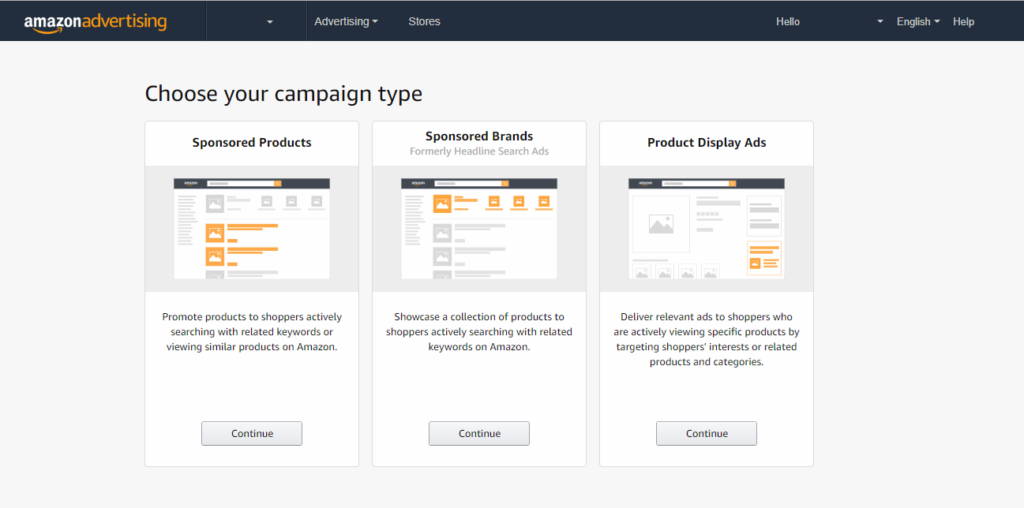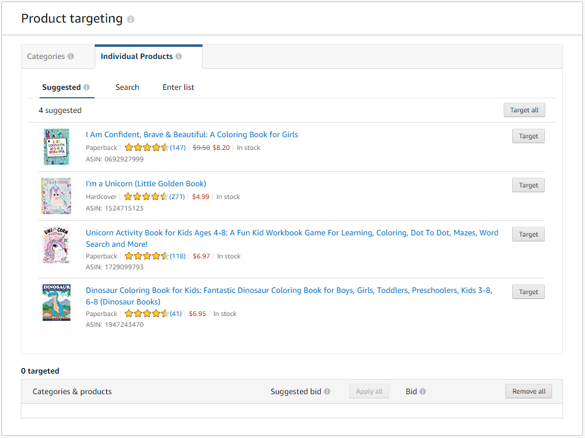Whether you’re an experienced Amazon seller looking to grow your sales or you’ve just set up shop yesterday, Amazon advertising is one of the best ways to get your product noticed…and purchased.
In one of our own cases, advertising on Amazon helped grow a brand’s revenue by 273% in 3 months. However, getting started with Amazon PPC can be overwhelming. How does Amazon advertising work? What types of ads should you run to reach your business goals? Where do those ads even show up?
To make it easier, we’ve written a quick guide to understand how Amazon advertising works and break down the distinctions between each ad format.
Types of Amazon Ads:
To start, there are three main types of campaigns or ads you can create in Amazon: Sponsored Product ads, Sponsored Brands ads, and Product Display ads. The first of these, Sponsored Product ads, are the most common.

Amazon Sponsored Product Ads
Sponsored Product ads are Amazon PPC advertising campaigns that are the most like the general PPC ads you would run in Google or Bing. This type of ad uses keyword and product targeting to advertise specific, individual products and appear alongside other products on the search results page or in a carousel on a product detail page.


SPONSORED PRODUCT TARGETING
Like other forms of online advertising, Sponsored Product ads use 3 different keyword match types to tie the keywords you bid on to a user’s search query.
KEYWORD MATCH TYPES:
- Broad Match: This match type allows for the most traffic and exposure. A customer’s search term must contain your keywords or synonyms for your keywords. These keywords can be anywhere in the searcher’s query, allowing for other words before, after, or in between the key phrase.
- Phrase Match: A customer’s search term must contain your keywords in sequence but allows for other words to appear before or after the phrase.
- Exact Match: A customer’s search query must exactly match your keyword in order for your ad to be shown. It is the most narrow type of keyword targeting available but also is more likely to be the most relevant to a shopper.
- Negative Keywords: These are words you do not want to bid or appear anywhere in the search queries that serve your ads.
As of late 2018, Amazon has launched a new targeting beta for Sponsored Product ads: Product Targeting. This allows sellers to serve their ads on individual product pages or serve their ad across products in a certain category. To learn more about this new beta and best practices for its use, check out Effective on Amazon’s new video, Amazon Sponsored Product Ads: Product Targeting Beta.


A seller or advertiser has the ability to edit the keywords and bids, the campaign’s total budget, and duration of campaigns. However, a product’s title, image, star rating are pulled from the product’s information and cannot be changed specifically for the ad. Sponsored Product ads look nearly indistinguishable from organic search results in Amazon, with the exception of the “Sponsored” ribbon below the product image.
Amazon determines where your ad appears in the search results (i.e. showing up on the 1st page versus 4th page of search results) based on what they call ad rank. You may be familiar with Google’s ad rank determination which boils down to a combination to of an ad’s relevance to the searcher’s query and their bid. Amazon, however, bases their ad rank on what the searcher is most likely to purchase.

To calculate this, Amazon looks at a number of different metrics including:
- Click-through-rate (CTR) history
- Conversion rate
- Total sales
- Product title & description
- Search terms
- Bid
Like Google, bidding can either be done manually or using one of Amazon’s automated strategies.
Sponsored Product ads appear in Amazon’s desktop and mobile sites along with the mobile app. Amazon has also stated that they continually test new placements for these ads, such as their email newsletters, so it’s important to stay up-to-date on where your ads can show.
Amazon Sponsored Brand Ads (Formerly Headline Search Ads)
Moving on to Sponsored Brand ads, formerly known as Headline Search ads. These ads are also pay-per-click ads that use keyword targeting, but instead of advertising one product at a time like Sponsored Product ads, Sponsored Brand ads showcase a few different products at a time.
Sponsored Brand ads appear at the very top of a search results page, above all organic listings and Sponsored Product ads.

There are two main components to a Sponsored Brand ad:
1. On the left are the brand’s logo, brand name, and call to action. When this half is clicked, a shopper is sent to either the brand’s store page, a curated page featuring a collection of products, or a custom Amazon URL. When setting up a Sponsored Brand campaign, the seller will be prompted to select among these three options for a landing page that would only affect clicks that occur on the logo or call to action.

2. On the right are 3 products chosen by the seller to advertise. Each of these products, when clicked, lead to their respective product detail page.


Like Sponsored Product ads, the ad creative on the left is also automatically generated based on product information.
SPONSORED BRAND TARGETING
Similar to Sponsored Product ads, Sponsored Brand ads also use keyword targeting. Advertisers can use keywords across all 3 different match types: exact, phrase, and broad. Amazon will also provide suggested keywords for bidding based on your product and product information.

Amazon Product Display Ads
Finally, there are Amazon Product Display ads. These ads are also Amazon PPC ads that lead to the product detail page. However, unlike the previous two ad types, these ads are only available to vendors. If you are not a registered vendor with Amazon, you won’t have the ability to run these ads.
These ads appear on a product’s detail page, on the right rail of the search results page, the bottom of the search results page, customer review pages, read all reviews pages, top of offer listing page, and in Amazon-generated marketing emails. Run across desktop, mobile, and mobile app.

PDA TARGETING
This ad format also has an entirely different targeting method compared to the previous two. Whereas the other used keyword targeting, PDAs give the option between the product or interest targeting.

Product targeting, like its name implies, targets a specific product which you can find by title or ASIN, or you can target a product category. As of a few months ago, you can also now target related categories which the ad builder automatically populated based on your product’s information.
Interest targeting allows advertisers to target specific interests or shoppers intent based on their searches. However, you cannot target both interest and product/category in a single campaign.

Unlike the previous two ad types, Product Display Ads give sellers a bit more control over the ad creative — this time sellers can add in their brand logo and write a custom headline. Product Display ads also have the highest amount of real estate available on Amazon — ads can appear on a product’s detail page, on the right rail of search results page, on the bottom of the search results page, on customer review pages, at the top of offer listing page, or in Amazon-generated marketing emails.
Bids are set a campaign level since there is no keyword targeting involved. This means that if you have multiple category targets in a single campaign, you can’t adjust bids based on the individual category, pushing bids higher for one category over the other. In order to adjust bids around individual categories, you would have to make multiple campaigns.
COUPON AD
Inside the Product Display Ad platform, vendors can also advertise a product coupon which operates like a Product Display Ad. To run a coupon ad, the product must have an active VPC (vendor powered coupon) which is a self-service promotion offering custom discounts on products.
Learn more about our Amazon and marketplace solutions and contact us to get started.





